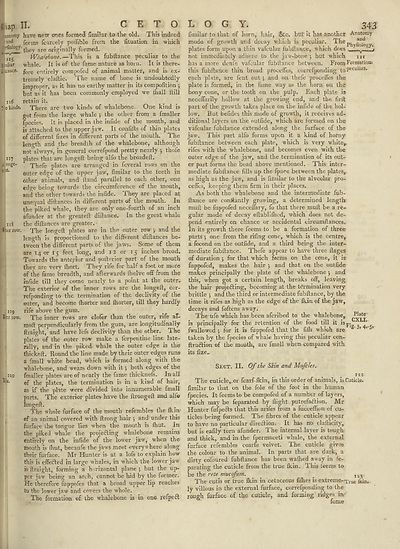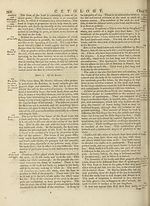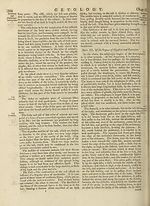Encyclopaedia Britannica, or, a Dictionary of arts, sciences, and miscellaneous literature : enlarged and improved. Illustrated with nearly six hundred engravings > Volume 5, BUR-CHI
(367) Page 343
Download files
Complete book:
Individual page:
Thumbnail gallery: Grid view | List view

I iap II. C E T O
Ibatomy have new ones formed firmlar to the old. This indeed
and feems fcareely pothble from the fituation in which
| ’('1°i°SJ' they are originally formed.
r^s'~ Whalebone.—This is a fubftance peculiar to the
I aliar whale. It is of the fame nature as horn. It is there-
j jitance. £ore entirely compofed of animal matter, and is ex¬
tremely elaftic. The name of bone is undoubtedly
improper, as it has no earthy matter in its compolition ;
but as it has been commonly employed we ihall Hill
it6 retain it.
' o kinds. There are two kinds of whalebone. One kind is
got from the large whale ; the other from a fmaller
Ipecies. It is placed in the infide of the mouth, and
is attached to the upper jaw. It confills of thin plates
of different fizes in different parts of the mouth. The
length and the breadth of the whalebone, although
not always, in general correfpond pretty nearly j thofe
L 117 plates that are longeft being alfo the broadeft.
j angc- Thefe plates are arranged in feveral rows on the
1 outer edge of the upper jaw, fimilar to the teeth in
other animals, and Hand parallel to each other, one
edge being towards the circumference of the mouth,
and the other towards the infide. They are placed at
unequal diftances in different parts of the mouth. In
the piked whale, they are only one-fourth of an inch
afunder at the greatefl diifance. In the great whale
: ixS the diftances are greater.
(kerrow. The longeft plates are in the outer rowr y and the
length is proportioned to the different diftances be¬
tween the different parts of the jaws. Some of them
are 14 or 15 feet long, and 12 or 15 inches broad.
Towards the anterior and pofterior part of the mouth
they are very fhort. They rife for half a foot or more
of the fame breadth, and afterwards fhelve off from the
infide till they come nearly to a point at the outer-
The exterior of the inner rows are the longeft, cor-
refponding to the termination of the declivity of the
outer, and become fhorter and fhorter, till they hardly
I 119 rife above the gum.
Ikr row. The inner rows are clofer than the outer, rife at-
moft perpendicularly from the gum, are longitudinally
ftraight, and have lefs declivity than the other. The
plates of the outer row make a ferpentine line late¬
rally, and in the piked whale the outer edge is the
thickeft. Round the line made by their outer edges runs
a fmall white bead, which is formed along with the
whalebone, and wears down with it •, both edges of the
.no fmaller plates are of nearly the fame thicknefs. In all
(^r* of the plates, the termination is in a kind of hair,
as if the plate were divided into innumerable fmall
parts. The exterior plates have the ftrongeft and alio
longeft.
The whole furface of the mouth refembles the fkin
of an animal covered with ftrong hair \ and under this
furfaee the tongue lies when the mouth is {hut. In
the piked whale the projecting whalebone remains
entirely on the infide of the lower jaw, when the
mouth is fhut, becaufe the jaws meet everywhere along
their furface. Mr Hunter is- at a lofs to explain how
this is effeCfed in large whales, in which the lower jaw
is ftraight, forming a horizontal plane •, but the up¬
per jaw being an arch, cannot be hid by the former.
He therefore fuppofes that a broad upper lip reaches
to the lower jaw and covers the whole.
The formation of the whalebone is in one- refpeCt
LOGY. 343
fknilar to that of horn, hair, See. but it has another Anatomy
mode of growth and decay which is peculiar. Thep,
plates form upon a thin vafcular i’ubftance, which does , , i
not immediately adhere to the jaw-bone \ but which m
has a more denfe vafcular fubftance between. From I'ormatioai
this fubftance thin broad proceifes, correfponding to Pfccunar-
each plate, are fent out ; and on thefe proceffes the
plate is formed, in the fame way as the horn on the
bony cone, or the tooth on the pulp. Each plate is
neceffarily hollow at the growing end, and the firft
part of the growth takes place on the infide of the hol¬
low. Rut belides this mode of growth, it receives ad¬
ditional layers on the outfide, which are formed on the
vafcular fubftance extended along the furface of the
jaw. This part alfo forms upon it a kind of horny
fubftance between each plate, which is very white,,
rifes with the whalebone, and becomes even with the
outer edge of the jaw, and the termination of its out¬
er part forms the bead above mentioned. This inter¬
mediate fubftance fills up the fpaee between the plates,
as high as the jaw, and is fimilar to the alveolar pro-
cefles, keeping them firm in their places.
As both the whalebone and the intermediate fub¬
ftance are conftantly growing, a determined length
mull be fuppofed neceffary, fo that there muft be a re¬
gular xnode of decay eftablifhed, which does not de¬
pend entirely on chance or accidental cireumftanees.
In its growth there feems to be a formation of three
parts \ one from the rifing cone, which is the centre,
a fecond on the outfide, and a third being the inter¬
mediate fubftance. Thefe appear to have three ftages
of duration ; for that which forms on the cone, it is
fuppofed, makes the hair j and that on the outfide
makes principally the plate of the whalebone ; and
this, when got a certain length, breaks off, leaving
the hair projefting, becoming at the termination very
brittle •, and the third or intermediate fubftance, by the
time it rifes as high as the edge of the fkin of the jaw,
decays and foftens away.
The ufe which has been aferibed to the whalebone, Plate
is principally for the retention of the food till it isp;^ 4
fwallowed ; for it is fuppofed that the fifti which are ’S*
taken by the fpecies of w hale having this peculiar con-
ftruiftion of the mouth, are fmall when compared with
its fize..
Sect. II. Of the Siin and Mufcles.
122
The cuticle, or fcarf-fkin, in this order of animals, is Cuticle,
fimilar to that on the foie of the foot in the human
fpecies. It feems to be compofed of a number of layers,
which may be feparated by flight putrefaftion. Mr
Hunter fufpe&s that this arifes from a fucceflion of cu¬
ticles being formed. The fibres of the cuticle appear
to have no particular diredtion; It has no elafticity,
but is eafily torn afunder. The internal layer is tough
and thick, and in the fpermaceti whale, the external
furface refembles coarfe velvet. The cuticle givos
the colour to the animal. In parts that are dark, a
dirty coloured fubftanee has been wafhed away in ie-
parating the cuticle from the true fkin. This feems to
be the rete mucofum. _
The cutis or true fkin in cetaceous fifties is extreme-True (kin.,
ly villous in the external furface, correfponding to the
rough furface of the cuticle, and forming ridges in-
„ feme
Ibatomy have new ones formed firmlar to the old. This indeed
and feems fcareely pothble from the fituation in which
| ’('1°i°SJ' they are originally formed.
r^s'~ Whalebone.—This is a fubftance peculiar to the
I aliar whale. It is of the fame nature as horn. It is there-
j jitance. £ore entirely compofed of animal matter, and is ex¬
tremely elaftic. The name of bone is undoubtedly
improper, as it has no earthy matter in its compolition ;
but as it has been commonly employed we ihall Hill
it6 retain it.
' o kinds. There are two kinds of whalebone. One kind is
got from the large whale ; the other from a fmaller
Ipecies. It is placed in the infide of the mouth, and
is attached to the upper jaw. It confills of thin plates
of different fizes in different parts of the mouth. The
length and the breadth of the whalebone, although
not always, in general correfpond pretty nearly j thofe
L 117 plates that are longeft being alfo the broadeft.
j angc- Thefe plates are arranged in feveral rows on the
1 outer edge of the upper jaw, fimilar to the teeth in
other animals, and Hand parallel to each other, one
edge being towards the circumference of the mouth,
and the other towards the infide. They are placed at
unequal diftances in different parts of the mouth. In
the piked whale, they are only one-fourth of an inch
afunder at the greatefl diifance. In the great whale
: ixS the diftances are greater.
(kerrow. The longeft plates are in the outer rowr y and the
length is proportioned to the different diftances be¬
tween the different parts of the jaws. Some of them
are 14 or 15 feet long, and 12 or 15 inches broad.
Towards the anterior and pofterior part of the mouth
they are very fhort. They rife for half a foot or more
of the fame breadth, and afterwards fhelve off from the
infide till they come nearly to a point at the outer-
The exterior of the inner rows are the longeft, cor-
refponding to the termination of the declivity of the
outer, and become fhorter and fhorter, till they hardly
I 119 rife above the gum.
Ikr row. The inner rows are clofer than the outer, rife at-
moft perpendicularly from the gum, are longitudinally
ftraight, and have lefs declivity than the other. The
plates of the outer row make a ferpentine line late¬
rally, and in the piked whale the outer edge is the
thickeft. Round the line made by their outer edges runs
a fmall white bead, which is formed along with the
whalebone, and wears down with it •, both edges of the
.no fmaller plates are of nearly the fame thicknefs. In all
(^r* of the plates, the termination is in a kind of hair,
as if the plate were divided into innumerable fmall
parts. The exterior plates have the ftrongeft and alio
longeft.
The whole furface of the mouth refembles the fkin
of an animal covered with ftrong hair \ and under this
furfaee the tongue lies when the mouth is {hut. In
the piked whale the projecting whalebone remains
entirely on the infide of the lower jaw, when the
mouth is fhut, becaufe the jaws meet everywhere along
their furface. Mr Hunter is- at a lofs to explain how
this is effeCfed in large whales, in which the lower jaw
is ftraight, forming a horizontal plane •, but the up¬
per jaw being an arch, cannot be hid by the former.
He therefore fuppofes that a broad upper lip reaches
to the lower jaw and covers the whole.
The formation of the whalebone is in one- refpeCt
LOGY. 343
fknilar to that of horn, hair, See. but it has another Anatomy
mode of growth and decay which is peculiar. Thep,
plates form upon a thin vafcular i’ubftance, which does , , i
not immediately adhere to the jaw-bone \ but which m
has a more denfe vafcular fubftance between. From I'ormatioai
this fubftance thin broad proceifes, correfponding to Pfccunar-
each plate, are fent out ; and on thefe proceffes the
plate is formed, in the fame way as the horn on the
bony cone, or the tooth on the pulp. Each plate is
neceffarily hollow at the growing end, and the firft
part of the growth takes place on the infide of the hol¬
low. Rut belides this mode of growth, it receives ad¬
ditional layers on the outfide, which are formed on the
vafcular fubftance extended along the furface of the
jaw. This part alfo forms upon it a kind of horny
fubftance between each plate, which is very white,,
rifes with the whalebone, and becomes even with the
outer edge of the jaw, and the termination of its out¬
er part forms the bead above mentioned. This inter¬
mediate fubftance fills up the fpaee between the plates,
as high as the jaw, and is fimilar to the alveolar pro-
cefles, keeping them firm in their places.
As both the whalebone and the intermediate fub¬
ftance are conftantly growing, a determined length
mull be fuppofed neceffary, fo that there muft be a re¬
gular xnode of decay eftablifhed, which does not de¬
pend entirely on chance or accidental cireumftanees.
In its growth there feems to be a formation of three
parts \ one from the rifing cone, which is the centre,
a fecond on the outfide, and a third being the inter¬
mediate fubftance. Thefe appear to have three ftages
of duration ; for that which forms on the cone, it is
fuppofed, makes the hair j and that on the outfide
makes principally the plate of the whalebone ; and
this, when got a certain length, breaks off, leaving
the hair projefting, becoming at the termination very
brittle •, and the third or intermediate fubftance, by the
time it rifes as high as the edge of the fkin of the jaw,
decays and foftens away.
The ufe which has been aferibed to the whalebone, Plate
is principally for the retention of the food till it isp;^ 4
fwallowed ; for it is fuppofed that the fifti which are ’S*
taken by the fpecies of w hale having this peculiar con-
ftruiftion of the mouth, are fmall when compared with
its fize..
Sect. II. Of the Siin and Mufcles.
122
The cuticle, or fcarf-fkin, in this order of animals, is Cuticle,
fimilar to that on the foie of the foot in the human
fpecies. It feems to be compofed of a number of layers,
which may be feparated by flight putrefaftion. Mr
Hunter fufpe&s that this arifes from a fucceflion of cu¬
ticles being formed. The fibres of the cuticle appear
to have no particular diredtion; It has no elafticity,
but is eafily torn afunder. The internal layer is tough
and thick, and in the fpermaceti whale, the external
furface refembles coarfe velvet. The cuticle givos
the colour to the animal. In parts that are dark, a
dirty coloured fubftanee has been wafhed away in ie-
parating the cuticle from the true fkin. This feems to
be the rete mucofum. _
The cutis or true fkin in cetaceous fifties is extreme-True (kin.,
ly villous in the external furface, correfponding to the
rough furface of the cuticle, and forming ridges in-
„ feme
Set display mode to:
![]() Universal Viewer |
Universal Viewer | ![]() Mirador |
Large image | Transcription
Mirador |
Large image | Transcription
Images and transcriptions on this page, including medium image downloads, may be used under the Creative Commons Attribution 4.0 International Licence unless otherwise stated. ![]()
| Permanent URL | https://digital.nls.uk/192989040 |
|---|
| Attribution and copyright: |
|
|---|
| Description | Ten editions of 'Encyclopaedia Britannica', issued from 1768-1903, in 231 volumes. Originally issued in 100 weekly parts (3 volumes) between 1768 and 1771 by publishers: Colin Macfarquhar and Andrew Bell (Edinburgh); editor: William Smellie: engraver: Andrew Bell. Expanded editions in the 19th century featured more volumes and contributions from leading experts in their fields. Managed and published in Edinburgh up to the 9th edition (25 volumes, from 1875-1889); the 10th edition (1902-1903) re-issued the 9th edition, with 11 supplementary volumes. |
|---|---|
| Additional NLS resources: |
|

